- Home
- Semester and Timetable Information
- Study Physics
- Our Research
- Our People
- Careers and Alumni
- Seminars, News and Events
- Outreach and School Resources
- About the School
- What is Physics
- The Crawford Observatory
- Frequently Asked Questions
- UCC Futures Quantum & Photonics
- Supports
- Symposium: Trace Gases and Radicals
Seminars 2019/2020
CANCELED
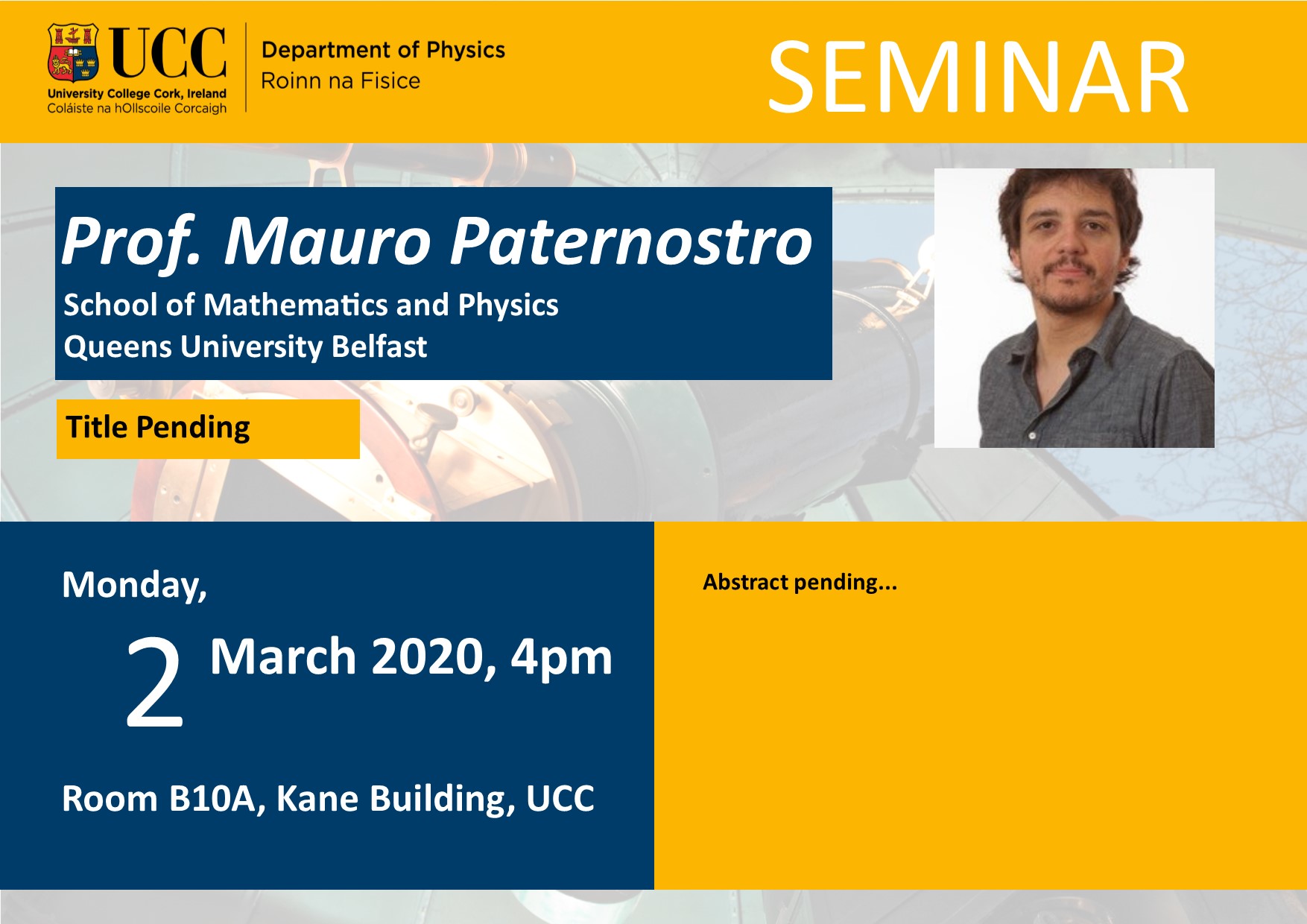
| Seminar Speaker: | Prof. Mauro Paternostro |
| Venue: | Room B10A, Kane Building, UCC |
| Date and Time: | 2nd March 2020, 4pm |
| Seminar Title: | |
| Abstract: Pending
|
|
24th February 2020

| Column 1 | Column 2 |
|---|---|
| Seminar Speaker: | Prof. Verònica Ahufinger |
| Venue: | Room B10A, Kane Building, UCC |
| Date and Time: | 24th February 2020, 4pm |
| Seminar Title: | Ultracold atoms carrying orbital angular momentum in lattices of rings: topology and quantum magnetism |
| Abstract: In this talk, we will discuss the physics of ultracold atoms carrying Orbital Angular Momentum (OAM) in lattices of ring potentials in the single-particle and in the Mott insulator limits. In the former limit, we find topologically protected edge states. In the latter limit, we show that the system can realize a variety of spin-1/2 models, including the XYZ Heisenberg model with or without external field. In the context of topology, we study the single-particle properties of a system formed by ultracold atoms loaded into the manifold of l=1 OAM states of an optical lattice with a diamond chain geometry [1,2]. Through a series of successive basis rotations, we show that the OAM degree of freedom induces phases in some tunneling amplitudes of the tight-binding model that are equivalent to a net flux through the plaquettes and give rise to a topologically non-trivial band structure and protected edge states. In addition, we demonstrate that the system also exhibits Aharanov-Bohm caging. In two dimensional (2D) lattices, we also propose a realization of a 2D high order topological insulator [3]. We describe the system in terms of two decoupled lattice models, each of them displaying one-dimensional edge states and zero-dimensional corner states that are correlated with the topological properties of the bulk. We show that this topologically non-trivial regime can be explored in a wide range of experimentally feasible values of the parameters of the physical system. Furthermore, we propose an alternative way to characterize the second-order topological corner states based on the computation of the Zak's phases of the bands of first-order edge states. In the Mott insulator limit, we focus on unit filling, where each trap is occupied by a single atom and a direct mapping between the OAM and spin-1/2 states can be performed [4]. We consider explicitly the dependence of the effective couplings on the geometry of the system and demonstrate that several models of interest related to a general XYZ Heisenberg model with external field can be obtained. Furthermore, we discuss how the relative strength of the effective couplings can be tuned and which phases can be explored by doing so in realistic setups. [1] G. Pelegrí, A. M. Marques, R. G. Dias, A. J. Daley, V. Ahufinger and J. Mompart, Topological edge states with ultracold atoms carrying orbital angular momentum in a diamond chain. Phys. Rev. A 99, 023612 (2019). [2] G. Pelegrí, A. M. Marques, R. G. Dias, A. J. Daley, J. Mompart and V. Ahufinger, Topological edge states and Aharanov-Bohm caging with ultracold atoms carrying orbital angular momentum. Phys. Rev. A 99, 023613 (2019). [3] G. Pelegrí, A. M. Marques, V. Ahufinger, J. Mompart, and R. G. Dias, Second-order topological corner states with ultracold atoms carrying orbital angular momentum in optical lattices, Phys. Rev. B. 100, 205109 (2019). [4] G. Pelegrí, J. Mompart, V. Ahufinger, A. J. Daley, Quantum magnetism with ultracold bosons carrying orbital angular momentum, Phys. Rev. A 100, 023615 (2019).
|
|
10th February 2020

| Seminar Speaker: | Prof. Paul Callanan and Prof. Niall Ó' Murchadha |
| Venue: | Room B10A, Kane Building, UCC |
| Date and Time: | 10th February 2020, 4pm |
| Seminar Title: | The 2019 Nobel Prize in Physics – a review |
| Abstract: The Nobel Prize in Physics 2019 was awarded "for contributions to our understanding of the evolution of the universe and Earth's place in the cosmos" with one half to James Peebles "for theoretical discoveries in physical cosmology", the other half jointly to Michel Mayor and Didier Queloz "for the discovery of an exoplanet orbiting a solar-type star." |
|
3rd February 2020
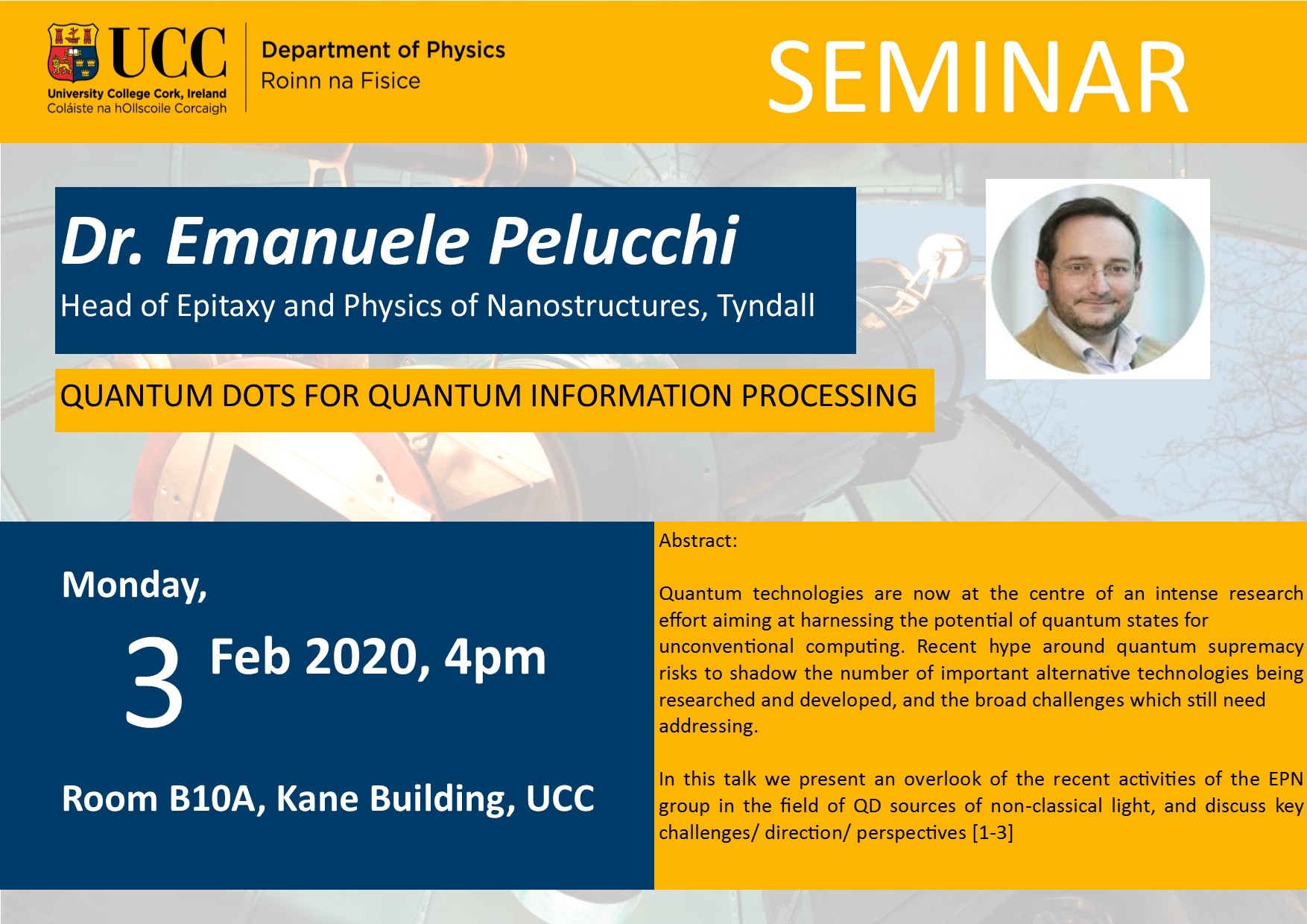
| Seminar Speaker: | Dr Emanuele Pelucchi |
| Venue: | Room B10A, Kane Building, UCC |
| Date and Time: | 3rd February 2020, 4pm |
| Seminar Title: | Quantum Dots for Quantum Informaiton Processing |
| Abstract: Quantum technologies are now at the centre of an intense research effort aiming at harnessing the potential of quantum states for unconventional computing. Recent hype around quantum supremacy risks to shadow the number of important alternative technologies being researched and developed, and the broad challenges which still need addressing. In this talk we present an overlook of the recent activities of the EPN group in the field of QD sources of non-classical light, and discuss key challenges/ direction/ perspectives [1-3] |
|
18th November 2019
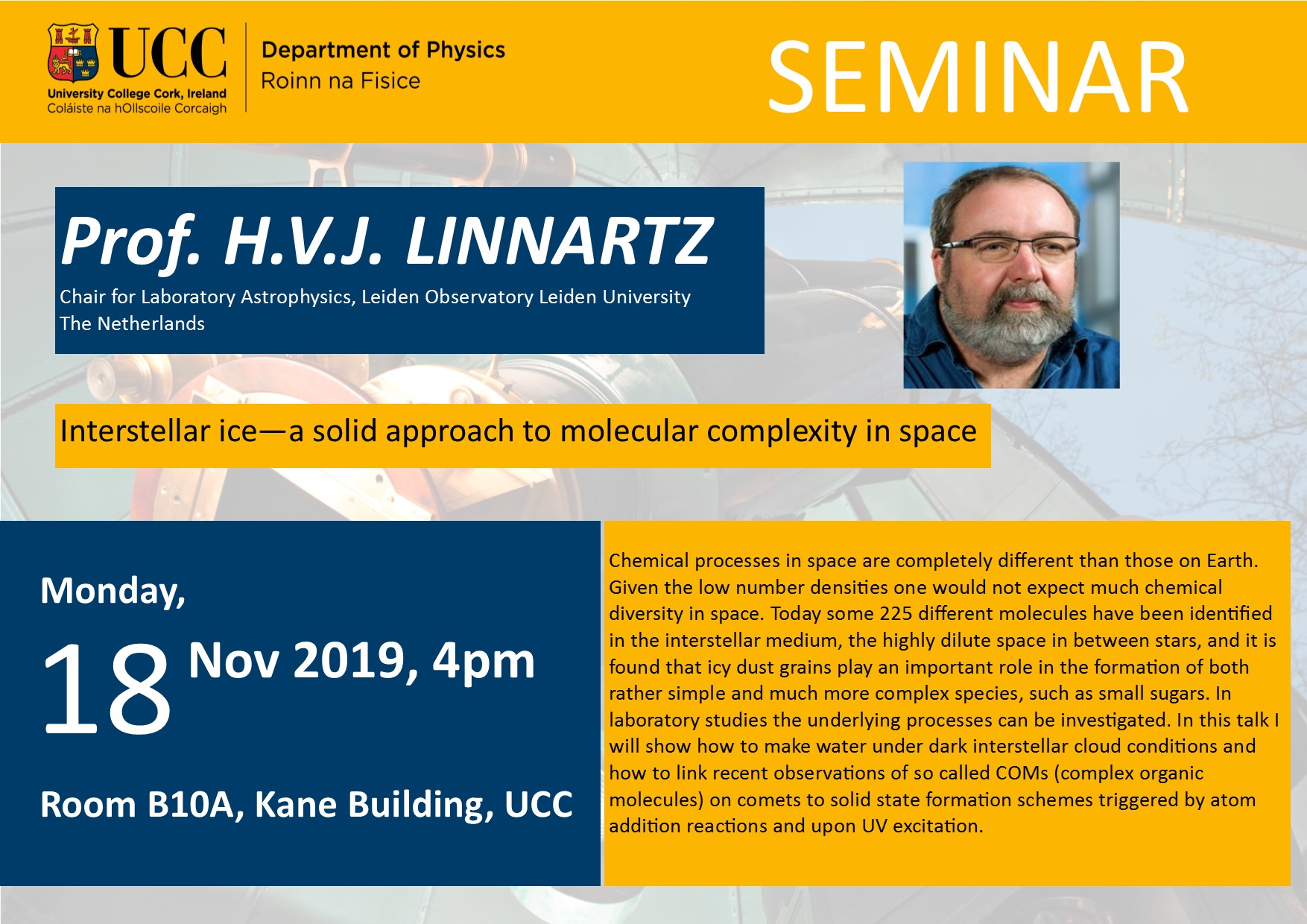
| Seminar Speaker: | Dr H.V.J. Linnartz |
| Venue: | Room B10A, Kane Building, UCC |
| Date and Time: | 18th November 2019, 4pm |
| Seminar Title: | Interstellar ice - a solid approach to molecular complexity in space |
| Abstract: Chemical processes in space are completely different than those on Earth. Given the low number densities one would not expect much chemical diversity in space. Today some 225 different molecules have been identified in the interstellar medium, the highly dilute space in between stars, and it is found that icy dust grains play an important role in the formation of both rather simple and much more complex species, such as small sugars. In laboratory studies the underlying processes can be investigated. In this talk I will show how to make water under dark interstellar cloud conditions and how to link recent observations of so called COMs (complex organic molecules) on comets to solid state formation schemes triggered by atom addition reactions and upon UV excitation. |
|
11th November 2019

| Seminar Speaker: | Steve Campbell |
| Venue: | Room B10A, Kane Building, UCC |
| Date and Time: | 11th November 2019, 4pm |
| Seminar Title: | Quantum speed limits: Practical tool. Fundamental insights. |
| Abstract: Uncertainty lies at the very heart of quantum mechanics. This notion is mathematically captured by the famous indeterminacy principles laid out by Heisenberg in 1927. One does not need to be a physics student to have come across the position-momentum uncertainty principle, while less well known is the energy-time (E-T) formulation. A remarkable outcome from the E-T uncertainty relation is the quantum speed limit, which uses the basic tenets of quantum mechanics to bound the minimal time a quantum system needs to evolve between two distinct states. In the last decades the study of the quantum speed limit has enjoyed a renewed interest partially driven by the rapid development of quantum technologies and quantum thermodynamic devices, where a minimal time sets the ultimate bounds on efficiency. Clearly then the QSL provides a practical tool for the design of optimal quantum devices. However, considering its origins, it is not surprising that recently there has been a growing interest in exploring how the quantum speed limit can provide some fundamental insights into the dynamics of quantum systems. The goal of this seminar is to introduce the basic aspects of quantum speeds limits and provide some examples of their broad utility. |
|
4th November 2019
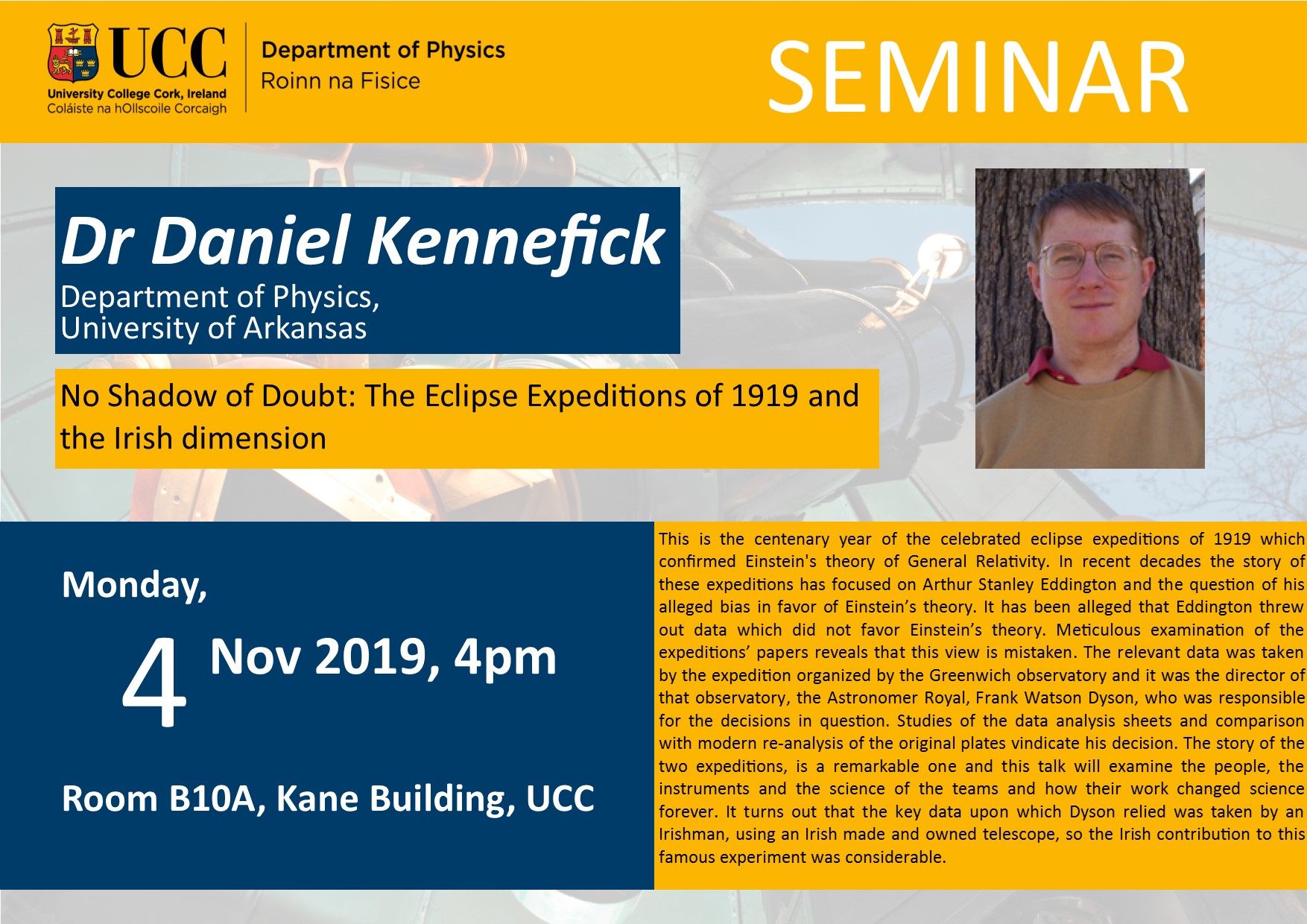
| Seminar Speaker: | Daniel Kennefick |
| Venue: | Room B10A, Kane Building, UCC |
| Date and Time: | 4th November 2019, 4pm |
| Seminar Title: | No Shadow of Doubt: The Eclipse Expeditions of 1919 and the Irish dimension |
| Abstract: This is the centenary year of the celebrated eclipse expeditions of 1919 which confirmed Einstein's theory of General Relativity. In recent decades the story of these expeditions has focused on Arthur Stanley Eddington and the question of his alleged bias in favor of Einstein’s theory. It has been alleged that Eddington threw out data which did not favor Einstein’s theory. Meticulous examination of the expeditions’ papers reveals that this view is mistaken. The relevant data was taken by the expedition organized by the Greenwich observatory and it was the director of that observatory, the Astronomer Royal, Frank Watson Dyson, who was responsible for the decisions in question. Studies of the data analysis sheets and comparison with modern re-analysis of the original plates vindicate his decision. The story of the two expeditions,is a remarkable one and this talk will examine the people, the instruments and the science of the teams and how their work changed science forever. It turns out that the key data upon which Dyson relied was taken by an Irishman, using an Irish made and owned telescope, so the Irish contribution to this famous experiment was considerable. |
|
21st October 2019
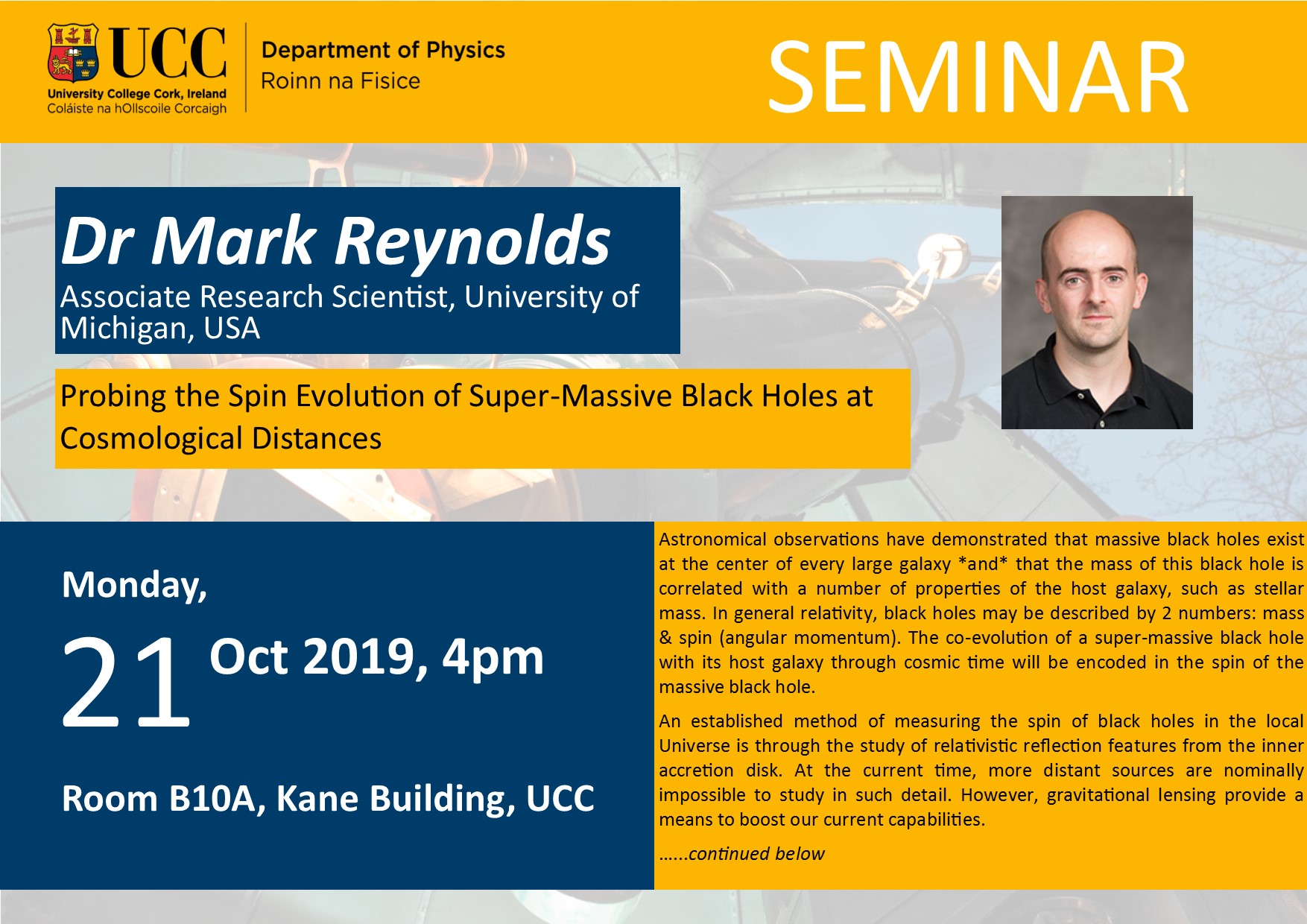
| Seminar Speaker: | Mark Reynolds |
| Venue: | Room B10A, Kane Building, UCC |
| Date and Time: | 21st October 2019, 4pm |
| Seminar Title: | Probing the Spin Evolution of Super-Massive Black Holes at Cosmological Distances |
| Abstract: Astronomical observations have demonstrated that massive black holes exist at the center of every large galaxy *and* that the mass of this black hole is correlated with a number of properties of the host galaxy, such as stellar mass. In general relativity, black holes may be described by 2 numbers: mass & spin (angular momentum). The co-evolution of a super-massive black hole with its host galaxy through cosmic time will be encoded in the spin of the massive black hole. An established method of measuring the spin of black holes in the local Universe is through the study of relativistic reflection features from the inner accretion disk. At the current time, more distant sources are nominally impossible to study in such detail. However, gravitational lensing provide a means to boost our current capabilities. I will discuss work wherein we have, for the first time, directly measured the spin of cosmologically distant super-massive black holes, by taking advantage of the boost in signal provided by gravitational lensing of distant Quasars. I will show how we can use this method to begin to assemble a sample of such systems to place direct constraints on the cosmological spin evolution of super-massive black holes. |
|
14th October 2019
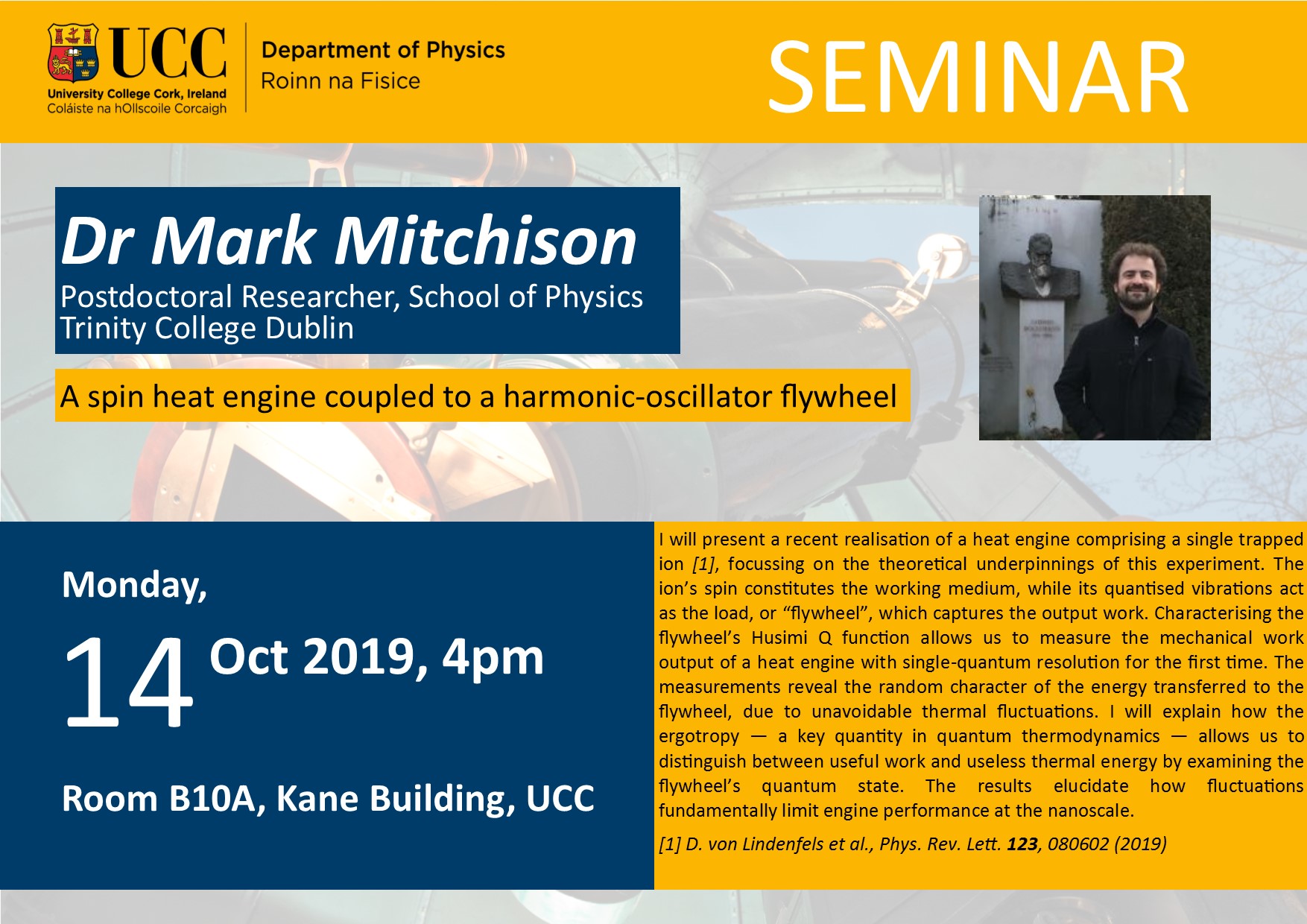
| Seminar Speaker: | Mark Mitchison |
| Venue: | Room B10A, Kane Building, UCC |
| Date and Time: | 14th October 2019, 4pm |
| Seminar Title: | A spin heat engine coupled to a harmonic-oscillator flywheel |
| Abstract: I will present a recent realisation of a heat engine comprising a single trapped ion [1], focussing on the theoretical underpinnings of this experiment. The ion’s spin constitutes the working medium, while its quantised vibrations act as the load, or “flywheel”, which captures the output work. Characterising the flywheel’s Husimi Q function allows us to measure the mechanical work output of a heat engine with single-quantum resolution for the first time. The measurements reveal the random character of the energy transferred to the flywheel, due to unavoidable thermal fluctuations. I will explain how the ergotropy — a key quantity in quantum thermodynamics — allows us to distinguish between useful work and useless thermal energy by examining the flywheel’s quantum state. The results elucidate how fluctuations fundamentally limit engine performance at the nanoscale. [1] D. von Lindenfels et al., Phys. Rev. Lett. 123, 080602 (2019) |
|
7th October 2019

| Seminar Speaker: | Benjamin Lingnau |
| Venue: | Room B10A, Kane Building, UCC |
| Date and Time: | 7th October 2019, 4pm |
| Seminar Title: | Nonlinear Laser Dynamics - an Introduction |
| Abstract: Laser dynamics describes the state of operation where a laser's output intensity is varying in time. Initially thought of as a nuisance, laser dynamics nowadays attracts a lot of attention as an enabling technology for future applications. Whether it's ultra-high-bandwidth telecommunications, highly sensitive measurement setups, or self-driving cars, laser dynamics has found its way into modern technology. |
|
16th September 2019
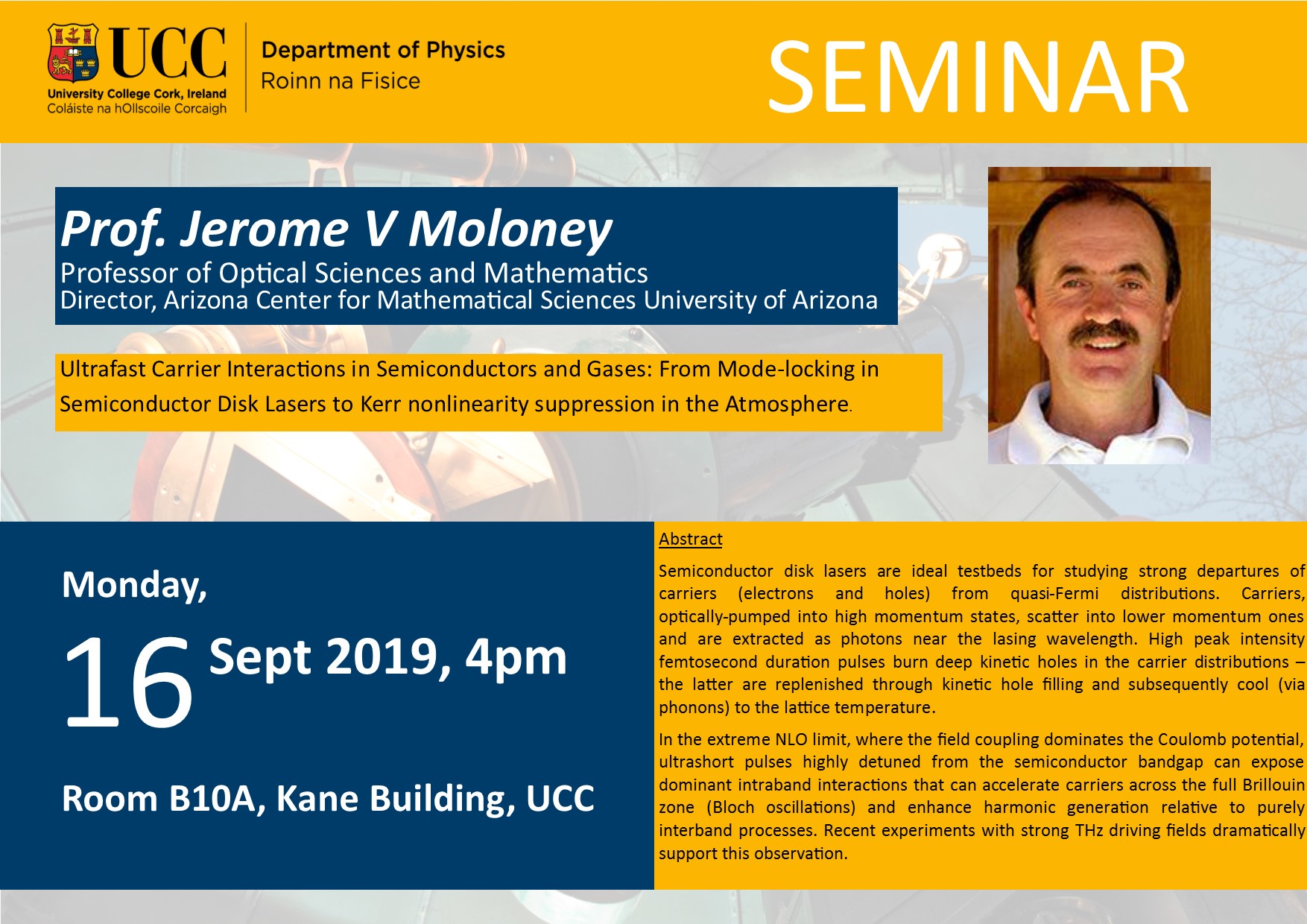
| Seminar Speaker: | Prof. Jerome V Moloney |
| Venue: | Room B10A, Kane Building, UCC |
| Date and Time: | 16tg September 2019, 4pm |
| Seminar Title: | Ultrafast Carrier Interactions in Semiconductors and Gases: From Mode-locking in Semiconductor Disk Lasers to Kerr nonlinearity suppression in the Atmosphere |
| Abstract: Semiconductor disk lasers are ideal testbeds for studying strong departures of carriers (electrons and holes) from quasi-Fermi distributions. Carriers, optically-pumped into high momentum states, scatter into lower momentum ones and are extracted as photons near the lasing wavelength. High peak intensity femtosecond duration pulses burn deep kinetic holes in the carrier distributions – the latter are replenished through kinetic hole filling and subsequently cool (via phonons) to the lattice temperature. In the extreme NLO limit, where the field coupling dominates the Coulomb potential, ultrashort pulses highly detuned from the semiconductor bandgap can expose dominant intraband interactions that can accelerate carriers across the full Brillouin zone (Bloch oscillations) and enhance harmonic generation relative to purely interband processes. Recent experiments with strong THz driving fields dramatically support this observation. Finally, in the intermediate limit of highly detuned USP interactions in gases, the effective Coulomb interaction being an order of magnitude stronger than in a semiconductor, can enhance many-body interactions between electrons transiently driven from individual nuclei. The latter disrupts the phase coherence of the induced polarization leading to a residual population of electrons in continuum states at intensities well below the tunnel ionization limit. A key consequence, is the prediction that multi-Joule 10µm ps pulses can be confined over multiple kilometer ranges in the atmosphere. In my talk, I will attempt to pull these apparently diverse phenomena together and illustrate with recent experiments that support them. |
|
